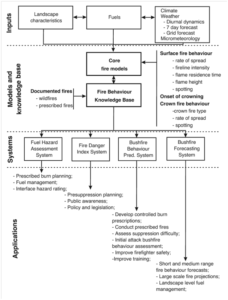Background
Accurate prediction of bushfire behaviour is essential for the effective planning and management of fire in the landscape. This knowledge enables the timely determination of the potential threat and impacts of a fire and provides the basis for sound fire-management decision-making. Fire behaviour prediction combines quantitative and qualitative information sources that are based on scientific principles and personal experience describing the combustion and behaviour of fire in a range of weather, fuel and topographic conditions. (Figure 1).
A flowchart showing how information flows into and out of Amicus
Amicus encompasses Australia’s fire behaviour and knowledge base and provides a method for easily accessing and updating that suite of knowledge in a user-sourced environment.
Amicus, the National Fire Behaviour Knowledge Base, is a new software tool that endeavours to provide a unique framework in which each of these information sources is accessible and utilisable in a consistent and comprehensive manner for the purpose of prediction of the behaviour of bushfires by trained fire behaviour analysts. The current version of Amicus contains only quantitative information of fire behaviour derived from our current set of recommended fire behaviour models for those vegetation types for which a quality rate of fire spread model exists.
Future development of Amicus aims to integrate the fire weather, fuel dynamics, and suppression capability knowledge and science to help fire managers better predict bushfire behaviour and better plan prescribed burns. It also aims to allow new knowledge, obtained from a variety of sources including personal observation, photographs, video and more objective sources, to be added to knowledge base to improve knowledge applicability.


